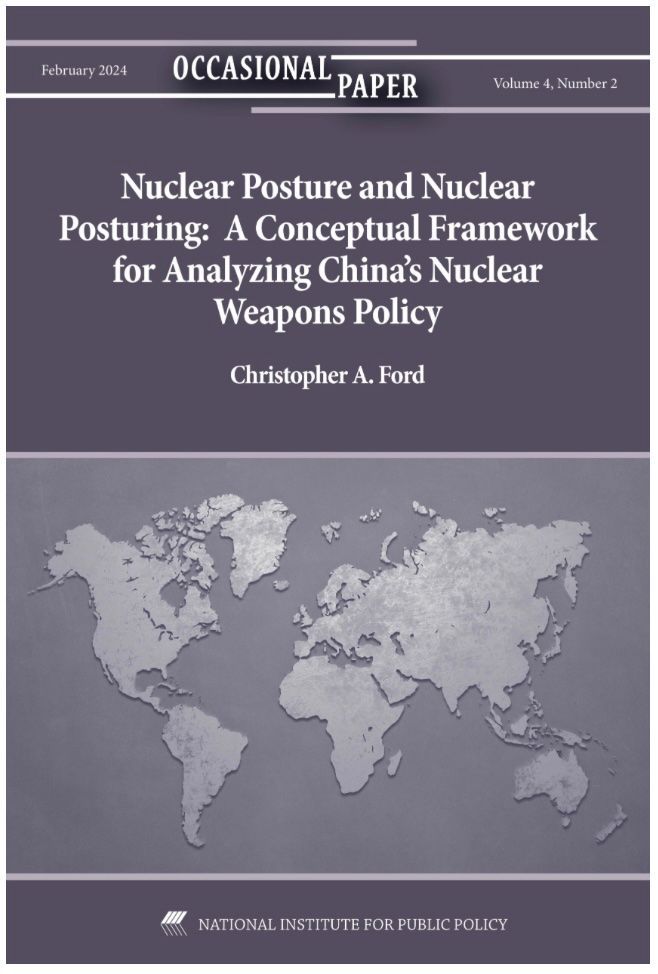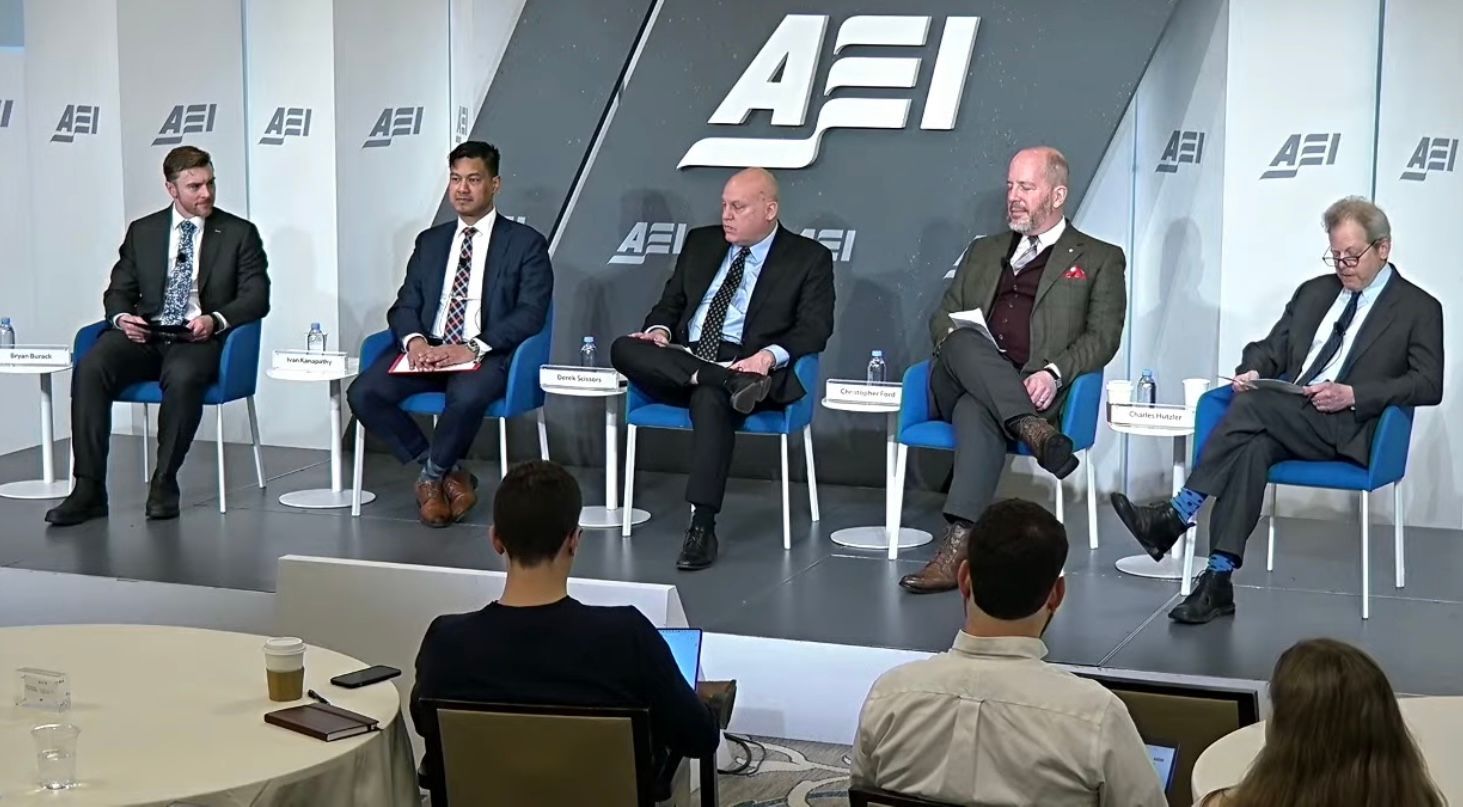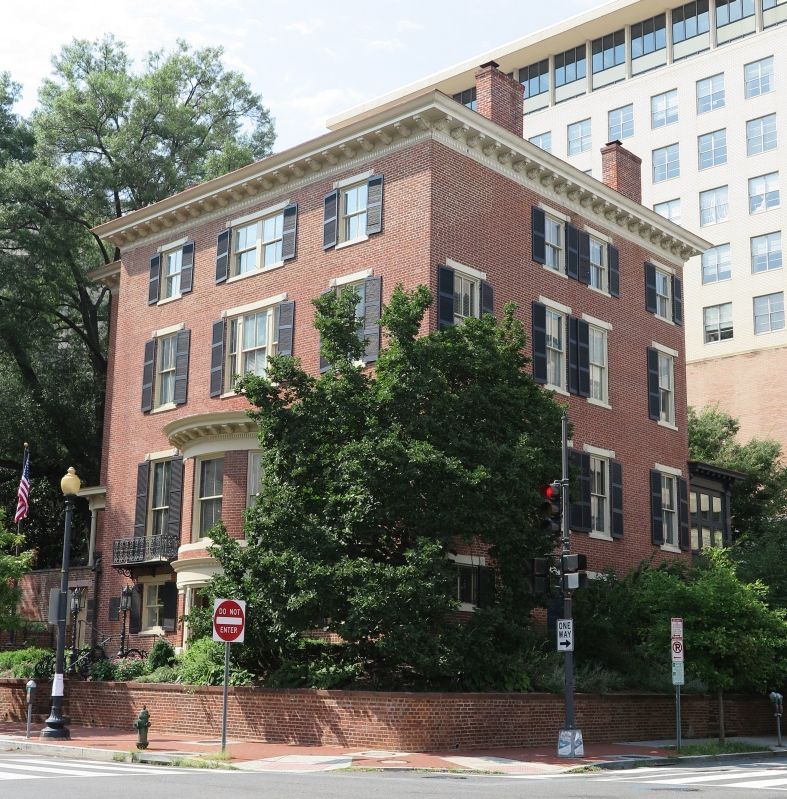The Hon. Christopher A. Ford
New Paradigms Forum -- International Security Policy Since 2009
Controlling Nuclear Materials Worldwide: Assessing the Summit
Note:
This is the written version of remarks presented by Christopher Ford on April 14, 2010, at a conference on “Assessing the Nuclear Security Summit” on sponsored by Hudson Institute and the Partnership for a Secure America .
Thanks, Andy. Let me start by thanking the Partnership for a Secure America for making this event possible. As always, it’s a pleasure to participate, and thank you for having me.
In the lead up to this week’s “Washington Nuclear Security Summit,” the Obama Administration and its friends in the media were fond of comparisons between this week’s “Washington Nuclear Security Summit” and the last such international meeting attended by so many heads of state. According to administration officials, the summit was “ the largest gathering of countries hosted by an American President dedicated to a specific issue like this in many decades, since the conference in San Francisco around the United Nations.”
Now that the summit has ended, however, the Obama team may regret such ambitious comparisons. Delegates to the San Francisco summit labored mightily, and gave birth to a new international order, creating a sweeping new set of international institutions by agreeing upon the United Nations Charter and the Statue of the International Court of Justice.
The attendees at this week’s summit have perhaps labored no less mightily, but by the standards of San Francisco, they have given birth to no more than a mouse.
With its negotiated statement , the attendees in Washington said some fine-sounding, if rather unspecific, things about the danger of nuclear terrorism and how governments hope to cooperate better in securing vulnerable materials worldwide , increase reliance upon low-enriched uranium (LEU) rather than highly-enriched uranium (HEU), and proclaimed the importance of a couple of fairly obscure international agreements – specifically, a 2005 amendment to the Convention on the Physical Protection of Nuclear Materials and the Convention for the Suppression of Acts of Nuclear Terrorism. ( Apparently no actual new ratifications of these agreements have been forthcoming, however.) Some countries made specific promises to tighten controls or reduce nuclear stocks , and Russia and the United States are apparently now finally going to implement a long-delayed agreement on disposing of plutonium from former nuclear weapons.
These are hardly bad things, and should be commended. One wonders, however, whether history will view this result as being worth the enormous expenditure of time, effort, and – scarce U.S. political capital entailed in organizing this huge summit.
I. Plans On Paper versus Facts on the Ground
The White House has made much of its intention to use this summit to come up with what President Obama said would be “ a specific work plan ,” characterized by “some very specific commitments” and “very specific steps” rather than “ just some vague, gauzy statement.”
The problem, however, is that when it comes to preventing nuclear terrorism, the world did not lack agreed work plans. The first major diplomatic initiative between heads of state focusing on the prevention of nuclear terrorism was the Global Initiative to Combat Nuclear Terrorism (GICNT), announced by President Bush and then-Russian President Vladimir Putin in 2006. Participants in GICNT has already grown to include fully 77 countries by February 2010. The Global Initiative has its own quite specific statement of principles , forming a program of action that ranges from information-sharing to physical protection, and from law enforcement and regulatory authorities to nuclear forensics. Rather than create airy political-level pronouncements, in fact, GICNT aims to “ focus on concrete operational-level cooperation.” Indeed, the Initiative is a process , not just a big meeting, and has already held at least five summits.
Another example is U.N. Security Council Resolution 1540. In some sense, in fact, Resolution 1540 accomplished vastly more than this summit’s mere articulation of general steps for countries to follow on a purely voluntary basis. Issued by the Security Council using its legal authority under Chapter VII of the United Nations Charter, Resolution 1540 actually created a binding legal obligation to take specific steps in combating nuclear terrorism – and indeed to prevent any non-state actor from any weapons of mass destruction (WMD) technology. It required all states to adopt and enforce laws to prohibit such activity, establish effective internal and export controls to prevent WMD proliferation, secure relevant items in transport or storage, augment border controls and law enforcement, sensors, end-user controls, and appropriate penalties for violations of export control rules. Moreover, it was not a mere political and voluntary “work plan” but actually a law.
So there really isn’t a lack of broad policy direction and legal guidance out there, nor any lack of countries willing to proclaim their good intentions and their desire to prevent bad things from happening. But of course that’s the easy part. As the old proverb has it, there can be many a slip twixt the cup and the lip: fine pronouncements, and even legal requirements, are only as good as parties’ willingness to act upon them.
Despite what Obama Administration officials would have one believe as they seek to claim the nuclear terrorism issue as their own despite so many years of prior U.S. work, the problem is not that we need a new “work plan” – much less merely that someone finally needs to “ raise the level of awareness and attention ” and “ trigger a common sense of urgency.” The real problem lies with many governments’ unwillingness to do enough once their heads of state return home. We don’t really need additional “plans on paper”: we just need new “facts on the ground.” And this is where the Washington Summit looks most mouselike.
President Obama promised in Prague in April 2009 to “ secure all vulnerable nuclear material around the world within four years.” That is now more than a year ago, however, so he now has only three years left. (To be sure, this deadline seems to be receding conveniently as time passes – and the White House was still talking this week about securing vulnerable material within “ four years.” The summit communiqué now picking up the “four years” refrain , apparently re-starting the clock yesterday afternoon.) Whether or not the president actually keeps his Prague promise, however, this is not a time merely for speechifying. As Obama himself told the delegates here in Washington, it is time “ not simply to talk, but to act.” That’s why it’s disappointing that this summit was so “ short of details on how this would be achieved.”
But I want to be fair. Perhaps this summit – with all its grandiosity and self-conscious scale – will indeed help catalyze real actions to change facts on the ground. Since President Obama has announced that there will be a follow-up summit in 2012, in South Korea , perhaps leaders will feel political pressure to produce at least some results in the interim. We shall see – though progress in that regard will probably hinge less upon anything that happened here in Washington this week than upon whether the Obama Administration is willing and able to devote sufficient political capital to keeping up a continuous pressure for results in the months and years ahead.
With regard to how to build upon this summit, let me say that it is a shame to see the Obama Administration so keen to hide the degree to which its focus upon preventing nuclear terrorism represents continuity with the policy of the Bush Administration, and with the Clinton Administration before that. To hear the Obama Administration tell it , one might think that the United States only recently realized that the Cold War is over and nuclear terrorism is a threat. But nothing, of course, could be further from the truth: this insight was a cornerstone of Bush policy, and very important under Bill Clinton as well. If Obama has somehow indeed seen farther than his predecessors it is because – as the old saying goes – he stood on their shoulders.
White House press releases stress President Obama’s visionary role , but the main things he seems to have added to the mix are an unrealistic four-year deadline, and this self-congratulatory spasm of a summit itself. Such self-aggrandizing amnesia is not unsurprising in Washington, though it is disappointing in a president once billed as a “transformative” and “post-political” chief executive. But today’s White House shouldn’t play hide-the-ball when it comes to the continuity in U.S. policy. To the contrary: it should embrace it. Nuclear terrorism is an issue that has long transcended politics and political party. The Administration should emphasize how it is building upon the work of past administrations – and it should use this approach as a model for how to approach national security issues an otherwise dysfunctional Washington political system.
But one should probably reserve judgment on this week’s huge summit. It is too early to tell whether it will be followed up by concrete action by the states whose leaders clogged our roadways this week.
II. Disappointments
That said, let me outline a few of the things I wish this summit had also managed to address – for there were some holes in its agenda.
• First, for instance, why were radiological dispersal devices (RDDs) – that is, so-called “dirty bombs” – so conspicuously left off the agenda? Whatever the actual probability of a terrorist attack using an actual nuclear weapon, the likelihood of an RDD assault is surely much higher: making one requires no special expertise, and radioactive isotopes suitable for the purpose are much easier to obtain than the weapons-grade fissile material needed for an actual nuclear explosive.
Yet although some countries reportedly mentioned the subject in their individual remarks, “dirty bombs” apparently featured essentially not at all in the summit proceedings. The final communiqué might perhaps be referring to this issue obliquely and in passing – noting that “ measures contributing to nuclear material security have value in relation to the security of radioactive substances” and that these latter substances should be secured “as well ” – but this is thin gruel indeed for a type of terrorist attack more likely to occur than nuclear weapons use.
• Second, one wonders why more immediate practical results were not at least sought. I infer that more concrete steps were felt to be “too hard” to achieve at the summit, but if this idea was too much even for the collective clout of all these heads of state, what will happen once the diplomatic pressure is off?
Given what we are told is a colossal threat – and indeed, “ today’s most immediate and extreme danger ” – should not we have tried to elicit actual contributions of money and manpower for the cause? U.S. efforts to secure vulnerable nuclear materials began years ago, in the mid-1990s, with the Nunn-Lugar legislation. These efforts, beginning with the Former Soviet Union and increasingly expanded onto a global stage under President Bush, have been funded to the tune of billions of dollars by U.S. taxpayers. They have also been undertaken largely, if not exclusively, by American personnel.
The Obama Administration wants to continue this expansion of Cooperative Threat Reduction (CTR), but doing this – and as quickly as the President has promised – will require vast amounts of money and expertise. Especially given the ruinous federal deficits today being run by the Obama Administration , there’s no way that paying for such work all over the world can remain a burden borne exclusively by the U.S. taxpayer. What role does President Obama envision for U.S. money and personnel in the international crash program the summit just proclaimed to ensure the security of everything, everywhere in short order? Why did President Obama not pass the hat, soliciting real contributions of money and personnel? Will this summit produce no more than leaders’ promises to go home and do their homework on their own?
• Third, almost nothing has been said about one of the most obvious potential problems in the fight against nuclear terrorism: the dangers that arise when state sponsors of terrorism acquire nuclear technology. So far, the rhetoric about “loose nukes” makes it sound as if the only thing anyone should worry is the accidental loss of nuclear materials to crafty terrorists. But the danger of deliberate transfers of technology – either as official policy or as a choice by radicalized elements within an already radicalized regime – is hardly trivial. French President Nicolas Sarkozy apparently proposed that transfers to terrorist groups be criminalized and prosecuted by some kind of international court , but the Obama Administration has been remarkably quiet about state sponsorship issues.
Perhaps the omission of the state-sponsorship threat is explainable by the Obama Administration’s lack of progress in actually doing anything about the nuclear weapons ambitions of the modern world’s most notorious state sponsors of terrorism ( e.g. , Iran, North Korea, and Syria). (To be sure, the Obama Administration has been trying to use the occasion of this summit to elicit China’s long-overdue support for serious Security Council sanctions against Tehran for its nuclear provocations, but this had nothing to do with terrorism – and so far Obama’s effort seems to have come to naught anyway.) Whatever the reason, except for that comment by Sarkozy, the issue of potential state sponsorship of nuclear terrorism seems to have been essentially taboo.
• Another unaddressed problem with nuclear materials security about which one hasn’t heard the Obama Administration talking – much less the summit pronouncing upon – is the proliferation of dual-use nuclear technology. It is certainly vital to secure vulnerable material and technology from exploitation by terrorists, but we are missing something profound if we ignore the problem of the increasing quantities of fissile material out there, and the spread of fissile material production capabilities around the world. Even charitably (and implausibly) assuming the genuinely peaceful intentions of everyone out there, the world faces the prospect of a significant expansion of nuclear energy, and nuclear material production capabilities. Yet under the Obama Administration – and even under its predecessor as well, I am sorry to say – the United States has been disturbingly silent in the face of widespread, if bogus, claims that every country in the world has a legal “right” to produce fissile material if it wants to.
Indeed, rather than simply neglecting this problem, the Summit’s communiqué probably makes things worse, by mouthing further platitudes about how “ the implementation of strong nuclear security practices” should “not infringe upon the rights of States to develop and utilize nuclear energy for peaceful purposes.” Technically speaking, I suppose, such vague phrasing is not necessarily a concession to the proliferators, but in diplomatic terms it is – clearly, predictably, and intentionally – a tip of the hat to tendentious arguments made by Iran and its apologists about the meaning of Article IV of the NPT. (As the New York Times somewhat coyly put it, this language in the communiqué “ might allow for confusion in dealing with a country like Iran, which insists – in the face of grave doubts abroad – that its advanced nuclear program is purely peaceful.”)
This seeming acquiescence to treaty-interpretive mischief is most unwise. Without addressing the issue of material supply and dual-use technology proliferation, focusing merely upon securing vulnerable material is likely to be an endless and losing battle, with success in fulfilling President Obama’s “four years” promise coming to resemble Little Orphan Annie’s “tomorrow”: it will always be a day away.
The Bigger Picture
Let me conclude by saying a word about the bigger picture. In a speech on April 12 to a conference of non-governmental organizations a few blocks away from the official meeting, former Australian foreign minister and anti-nuclear activist Gareth Evans provided a window into how the disarmament community views this summit. His remarks may help explain why the White House seems so focused upon the mere symbolism and atmospherics of the event.
As Evans described it, the 2010 is a pivotal year for the international disarmament agenda: the movement perceives itself to have an enormous opportunity – one that has been afforded it by the election of President Obama, and which is rather unlikely ever to repeat itself. In his view, it is essential to capitalize upon 2010 as a year of opportunity, lest the entire disarmament agenda begin to disintegrate.
In this regard, Evans outlined seven “key benchmark issues,” upon progress on which hinges the overall success or failure of the anti-nuclear-weapons agenda. (In effect – though Evans didn’t use these words – the idea seemed to be that “if we can’t make significant progress on these things now, we should take it as a sign that we never will.”) Significantly, however, he described six of these seven as being beset by various sorts of problems or at least uncertainties, ranging from the worrisome to the downright grave:
1. The Comprehensive Test Ban Treaty (CTBT) faces obvious problems in the U.S. Senate, and has essentially zero prospect of ratification in 2010.
2. The Fissile Material Cutoff Treaty (FMCT) remains “hopelessly snarled” in the Conference on Disarmament (CD). [ Note: Interestingly, Evans even mused about pursuing FMCT outside the CD – long a heretical idea in disarmament circles, but one I advocated in Arms Control Today .]
3. Iran’s nuclear work continues, with little chance of diplomatic solution.
4. The forthcoming Nuclear Nonproliferation Treaty (NPT) Review Conference was long thought a source of Obama Administration optimism, but Evans recounts growing anxiety and worries about how well things are now expected actually to go.
5. Evans described President Obama’s recent Nuclear Posture Review as being only “qualified” good news, apparently being put off by the incompleteness of the changes it made in U.S. declaratory policy. [ Note: Click here , here , and here for NPF’s discussion of the Review.]
6. Even prospects for the new post-START agreement with Russia seemed to worry Evans, who cited Senator Joseph Lieberman’s recent assessment that it may not have enough votes for Senate ratification.
The seventh issue Evans described was this week’s Nuclear Security Summit – the success of which he described as being “critical” precisely because of all the worries and uncertainties associated with the other six. Without meaning to, perhaps, Evans thus provided a window into the fragile state of President Obama’s Nobel-endorsed nuclear disarmament agenda. This Administration apparently desperately needs an unqualified anti-nuclear “success,” and in the eyes of disarmament luminaries such as Evans, at least, this summit is the only one that the president can show to date.
And that may help explain a lot. One hopes, however, that the White House’s focus upon proclaiming success will not crowd out the hard work and sustained effort that will actually be required to achieve some.
-- Christopher Ford



Copyright Dr. Christopher Ford All Rights Reserved






